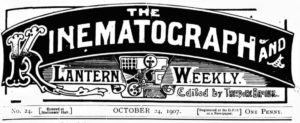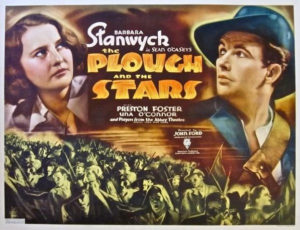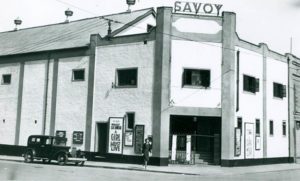A Criminal History of Cinemas in Northern Ireland Part I: Crime in the Picture Houses
Cinemas are sites of entertainment, escapism and education, places of sanctuary to watch films free from the distractions of the outside world. But they are also vibrant social spaces deeply embedded within their local communities.
They respond to wider social, economic and political developments and, during Northern Ireland’s peak years of cinema attendance from the 1920s to the 1960s, were often sites of criminal activity including theft, disorderly behaviour and in one case, murder.
Court reports printed in local newspapers and trade journals offer evidence on the location and the nature of criminal activity, the people who committed these offences and the severity of the fines or prison sentences imposed by prosecutors. These reports are highly selective, reflecting the crimes that went to trial or the incidents that journalists felt might interest their readers. They do, however, offer an insight into some of the challenges faced by cinema exhibitors and the impact of criminal activity on cinema attendance across Northern Ireland.
 Cinemas were not immune from the wave of sectarian and political violence that swept Belfast from 1920 to 1922. In May 1922, a year after the formation of Northern Ireland, a group of raiders entered the city’s Gaiety and Imperial cinemas, located on North Street and Corn Market respectively. The latter, reported trade journal Kinematograph Weekly, ‘was visited by about thirty armed men who, separating into groups, went into various portions of the building, sprinkling petrol and sawdust on their way’. Though staff foreman John Killen was beaten on the head with revolvers he escaped through the back stairs and raised the police alarm. The subsequent arrival of the police startled the raiders who then escaped undetected.
Cinemas were not immune from the wave of sectarian and political violence that swept Belfast from 1920 to 1922. In May 1922, a year after the formation of Northern Ireland, a group of raiders entered the city’s Gaiety and Imperial cinemas, located on North Street and Corn Market respectively. The latter, reported trade journal Kinematograph Weekly, ‘was visited by about thirty armed men who, separating into groups, went into various portions of the building, sprinkling petrol and sawdust on their way’. Though staff foreman John Killen was beaten on the head with revolvers he escaped through the back stairs and raised the police alarm. The subsequent arrival of the police startled the raiders who then escaped undetected.
A more serious incident occurred three months later when 56-year-old Peter Mullan, assistant manager at Belfast’s Crumlin Picture House, was shot dead by loyalist gunmen. On the night before the murder, Mullan ejected three men for bad conduct, one of whom was heard to say ‘we will get that man yet’. These men returned the following night and fired three shots at Mullan, who was standing near the screen. Trade paper The Bioscope reported that ‘assailant escaped in the course of the confusion which followed the completion of the shocking crime. On the part of the women and children a panic was created, and there was a wild rush for the doors and into the street’. Mullan was then taken to a nearby medical hall where his death was confirmed.

Many other disturbances were related to what was shown on the screen, particularly films concerning Irish history and politics. During a 1937 screening of John Ford’s Easter Rising drama The Plough and the Stars at an Omagh cinema, ‘youths threw stinks bombs which exploded in different parts of the house and also hit patrons’. Two years later Belfast’s Clonard Picture House on the Falls Road showed Macushla, a film about arms smuggling across the Irish border: ‘At a given signal a whistle blew and a large body of men in the audience rose and flung bottles of ink and tomatoes at the screen, with the result that the screen was completely destroyed and the curtains damaged’. The cinema manager also recalled a previous attack in response to a newsreel appeal for the Territorial Army.
The Second World War created new tensions as many Republicans were critical of Northern Ireland’s participation in the conflict. In 1940, Kinematograph Weekly reported on a wave of damage to Derry cinemas resulting from the IRA’s campaigns against the showing of war newsreels. It reported on an unexploded bomb left at the city’s Strand cinema and other minor incidents such as the theft of film reels and the release of stink bombs. The IRA also used cinemas as a space to spread its message. In 1943, several escaped IRA prisoners entered the Broadway cinema, Falls Road, forced the projectionist to stop the show and ordered the audience to ‘sit still and listen’. Hugh McAteer, IRA chief of staff, then issued a warning to the USA against stationing troops in Ireland. After a short Easter Rising commemoration ceremony, the men then left the cinema.
In 1953 A Queen is Crowned, a Technicolor documentary showing the coronation of Queen Elizabeth II at Westminster Abbey, was the most popular film at the UK box office and also did excellent business in many Northern Ireland cinemas. But here it was also a controversial film leading some people to use drastic measures to prevent its screening.

In the early hours of 15 June a time bomb exploded at Newry’s Savoy cinema, damaging the balcony and tearing a hole in a steel girder. In the following month, also during the early hours of the morning, a bomb was thrown into the Banbridge Picture House. Although it caused significant damage to the foyer, the film was still shown as planned.
